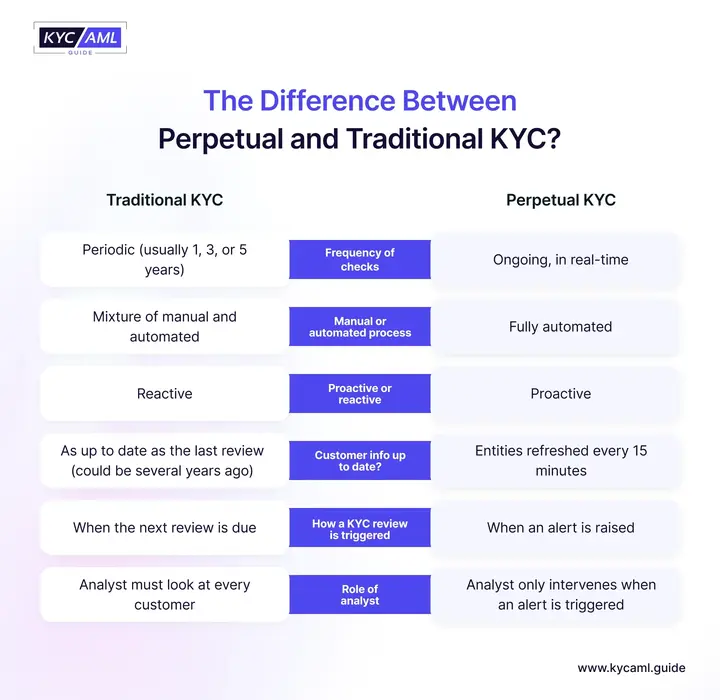What is Perpetual KYC?
Perpetual KYC provides a digital approach to compliance requirements and due diligence. It requires companies to maintain an accurate and up-to-date profile of their customers. It is commonly used for AML and KYC compliance. Periodic KYC is insufficient due to high costs and low customer satisfaction. Perpetual KYC also known as continuous risk monitoring can fill these gaps and provide benefits in the form of risk reduction and increased efficiency. This system does not remove the need for continuous updates but complements the existing system. With perpetual KYC, you’ll be notified as soon as a risk arises so you can make the right decisions quickly.
Companies are eager to find ways to increase compliance and reduce customer risk. Interest in pKYC has increased following the application by the
- Financial Crimes Enforcement Network (FinCEN),
- The Sixth Anti-Money Laundering Directive (6AMLD) and
- Anti-money laundering (AML) legislation.
pKYC uses a powerful verification process based on AI tools that goes beyond the traditional customer verification process. This process continues to help companies identify and manage fraud issues or risks more effectively.
Components of pKYC
| Automatic identity verification | pKYC automates identity verification by using artificial intelligence and machine learning. It reduces reliance on manual checks and increases overall efficiency. |
| Real-time alerts | pKYC enables immediate detection of anomalies by analyzing customer data in real-time and prompts immediate action. This facilitates risk reduction and improves overall rapid response to potential problems. |
| Ongoing monitoring | pKYC works without waiting for personal verification to update customer information, unlike traditional KYC. When further investigation is necessary, the “trigger” or “alert” starts the customer due diligence (CDD) process. This process is triggered by factors such as suspicious activity, a new business name, or a customer changing identity information |
The main differences between traditional KYC and perpetual KYC are given below in the infographic.

Benefits of implementing KYC
Adopting a pKYC system can have transformative benefits for financial institutions and organizations. These include:
1) Efficiency and Effectiveness
Perpetual KYC automated KYC verification system. It increases the operational efficiency and ensures optimal allocation of resources.
2) Real-time Risk Analysis
Real-time monitoring of customer information helps you immediately identify and mitigate potential risks.
Also Read: Risk-Based Approach In KYC/AML
3) Compliance and Fraud Risk Mitigation
pKYC helps reduce compliance and fraud risk across a company’s portfolio by rapidly addressing risk changes in an organization
4) Better customer experience
pKYC reduces the need for paperwork and reduces customer friction and streamlines the customer onboarding and due diligence process. Likewise, constant updates of customer information allow financial organizations to give a more customized and effective customer experience.
5) Streamlined Remediation Process
Perpetual KYC eliminates the need for time-consuming and labor-intensive KYC remediation. In KYC remediation the customer information is continuously maintained and updated. This results in an economical and efficient compliance process.
6) Strategic Benefits
Shifting to pKYC can transform a compliance department from a mere cost center into a valuable asset, potentially contributing to an organization’s financial growth.
7) Regulatory Framework
With the increasing implementation of pKYC regulators expect its implementation to become standard practice.
8) Revenue Opportunities
pKYC can help to enhance customer relationships and generate revenue from the insights obtained from real-time data changes.
Best Practices for Implementing Perpetual KYC
Financial institutions should consider the following best practices to successfully implement a perpetual KYC approach
i) Develop a Comprehensive Strategy
Financial institutions should develop a comprehensive strategy before implementing perpetual KY that outlines the objectives, scope, and timing of the project.
ii) Collaboration with Interested Parties
To ensure a collaborative and coordinated approach to pKYC implementation engage stakeholders across the organization, including compliance, IT, and business teams
iii) Take Advantage of Advanced Technology
To automate and improve the ongoing pKYC process modern technologies like artificial intelligence, machine learning, and big data analytics are used. They reduce the manual workload and improve operational efficiency.
iv) Monitor Regulatory Changes
To ensure that pKYC due diligence complies with applicable laws and guidelines stay abreast of regulatory changes..
v) Measure and Optimize Performance
To optimize performance and results make changes as necessary in the pKYC process. Also continuously monitor and measure the effectiveness of perpetual KYC processes.
Meeting the Challenges
Organizations should be ready to implement new processes and tools to deal with the enormous measure of data produced as pKYC acquires popularity. The integration of advanced technology AI-powered solutions and data analytics can smooth out the processes and provide actionable insights to compliance teams.
The introduction of perpetual KYC seemed like a significant paradigm shift in the ever-evolving financial compliance environment. Organizations can address complex compliance with agility and prediction by leveraging the power of continuous monitoring and real-time risk assessment. In today’s dynamic financial ecosystem, adopting this transformative approach not only improves risk management but also makes compliance departments a strategic tool that ultimately contributes to growth and resilience.
KYC AML guide is the best consultancy that will help you select the best KYC solutions for KYC identity verification by offering services like KYC technology buying.





